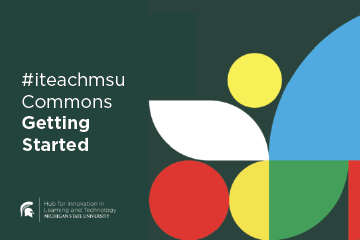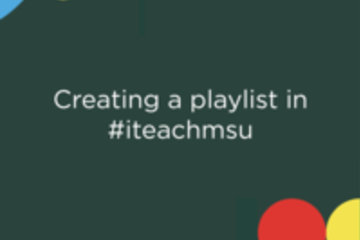Browse
Incorporating Technologies
Posted on: #iteachmsu

Creates more engaged and successful teachers,Technology is an integral part of how we work and livee
Technology integration is the use of technology tools in general content areas in education in order to allow students to apply computer and technology skills to learning and problem-solving.
Creates more engaged and successful teachers.
Using technologies like virtual lesson plans and internet resources can help free up time — both in developing and delivering the curriculum. This allows teachers to spend more time with the students who are struggling, ensuring the whole class is better prepared for tests and advancement.
As an educator, integrating technology into the curriculum is key. In other words, don’t just add a piece of technology to a lesson plan just because you can. Make sure you understand:
How to use the technology
How to train students on using the technology
How the technology supports your curriculum
What benefits the technology brings to your lesson
An easy way to introduce technology is to start small.
Creates more engaged and successful teachers.
Using technologies like virtual lesson plans and internet resources can help free up time — both in developing and delivering the curriculum. This allows teachers to spend more time with the students who are struggling, ensuring the whole class is better prepared for tests and advancement.
As an educator, integrating technology into the curriculum is key. In other words, don’t just add a piece of technology to a lesson plan just because you can. Make sure you understand:
How to use the technology
How to train students on using the technology
How the technology supports your curriculum
What benefits the technology brings to your lesson
An easy way to introduce technology is to start small.
Authored by:
Computer security, cybersecurity or information technolog...
Posted on: #iteachmsu

Data structures
A data structure is a specialized format for organizing, processing, retrieving and storing data. There are several basic and advanced types of data structures, all designed to arrange data to suit a specific purpose. Data structures make it easy for users to access and work with the data they need in appropriate ways. Most importantly, data structures frame the organization of information so that machines and humans can better understand it.
In computer science and computer programming, a data structure may be selected or designed to store data for the purpose of using it with various algorithms. In some cases, the algorithm's basic operations are tightly coupled to the data structure's design. Each data structure contains information about the data values, relationships between the data and -- in some cases -- functions that can be applied to the data.
For instance, in an object-oriented programming language, the data structure and its associated methods are bound together as part of a class definition. In non-object-oriented languages, there may be functions defined to work with the data structure, but they are not technically part of the data structure.
Why are data structures important?
Typical base data types, such as integers or floating-point values, that are available in most computer programming languages are generally insufficient to capture the logical intent for data processing and use. Yet applications that ingest, manipulate and produce information must understand how data should be organized to simplify processing. Data structures bring together the data elements in a logical way and facilitate the effective use, persistence and sharing of data. They provide a formal model that describes the way the data elements are organized.
Data structures are the building blocks for more sophisticated applications. They are designed by composing data elements into a logical unit representing an abstract data type that has relevance to the algorithm or application. An example of an abstract data type is a "customer name" that is composed of the character strings for "first name," "middle name" and "last name."
It is not only important to use data structures, but it is also important to choose the proper data structure for each task. Choosing an ill-suited data structure could result in slow runtimes or unresponsive code. Five factors to consider when picking a data structure include the following:
What kind of information will be stored?
How will that information be used?
Where should data persist, or be kept, after it is created?
What is the best way to organize the data?
What aspects of memory and storage reservation management should be considered?
How are data structures used?
In general, data structures are used to implement the physical forms of abstract data types. Data structures are a crucial part of designing efficient software. They also play a critical role in algorithm design and how those algorithms are used within computer programs.
Early programming languages -- such as Fortran, C and C++ -- enabled programmers to define their own data structures. Today, many programming languages include an extensive collection of built-in data structures to organize code and information. For example, Python lists and dictionaries, and JavaScript arrays and objects are common coding structures used for storing and retrieving information.
Software engineers use algorithms that are tightly coupled with the data structures -- such as lists, queues and mappings from one set of values to another. This approach can be fused in a variety of applications, including managing collections of records in a relational database and creating an index of those records using a data structure called a binary tree.
In computer science and computer programming, a data structure may be selected or designed to store data for the purpose of using it with various algorithms. In some cases, the algorithm's basic operations are tightly coupled to the data structure's design. Each data structure contains information about the data values, relationships between the data and -- in some cases -- functions that can be applied to the data.
For instance, in an object-oriented programming language, the data structure and its associated methods are bound together as part of a class definition. In non-object-oriented languages, there may be functions defined to work with the data structure, but they are not technically part of the data structure.
Why are data structures important?
Typical base data types, such as integers or floating-point values, that are available in most computer programming languages are generally insufficient to capture the logical intent for data processing and use. Yet applications that ingest, manipulate and produce information must understand how data should be organized to simplify processing. Data structures bring together the data elements in a logical way and facilitate the effective use, persistence and sharing of data. They provide a formal model that describes the way the data elements are organized.
Data structures are the building blocks for more sophisticated applications. They are designed by composing data elements into a logical unit representing an abstract data type that has relevance to the algorithm or application. An example of an abstract data type is a "customer name" that is composed of the character strings for "first name," "middle name" and "last name."
It is not only important to use data structures, but it is also important to choose the proper data structure for each task. Choosing an ill-suited data structure could result in slow runtimes or unresponsive code. Five factors to consider when picking a data structure include the following:
What kind of information will be stored?
How will that information be used?
Where should data persist, or be kept, after it is created?
What is the best way to organize the data?
What aspects of memory and storage reservation management should be considered?
How are data structures used?
In general, data structures are used to implement the physical forms of abstract data types. Data structures are a crucial part of designing efficient software. They also play a critical role in algorithm design and how those algorithms are used within computer programs.
Early programming languages -- such as Fortran, C and C++ -- enabled programmers to define their own data structures. Today, many programming languages include an extensive collection of built-in data structures to organize code and information. For example, Python lists and dictionaries, and JavaScript arrays and objects are common coding structures used for storing and retrieving information.
Software engineers use algorithms that are tightly coupled with the data structures -- such as lists, queues and mappings from one set of values to another. This approach can be fused in a variety of applications, including managing collections of records in a relational database and creating an index of those records using a data structure called a binary tree.
Posted by:
Sharon

Posted on: #iteachmsu


Data structures
A data structure is a specialized format for organizing, processing...
Posted by:
Wednesday, Jul 21, 2021
Posted on: #iteachmsu

Setup and Structure
Without saying a word, classrooms send messages about diversity, relationship building, communication, and the roles of teachers and students. The classroom setup should be student-centered. Specifics will vary from teacher to teacher and class to class, but common elements include the following:
Classroom milieu. Classrooms should be decorated with multicultural images that mirror students’ backgrounds and showcase the diversity of our society.
Arrangement of furniture and supplies. The arrangement will look different depending on age group and subject, but all teachers can draw on these goals when setting up a classroom: supporting collaboration, fostering dialogue, encouraging ownership, and ensuring comfort.
Student roles and responsibilities. Classrooms will be most effective when they are structured to maximize students’ voices and participation.
Classroom norms. Norms and expectations should take into account different cultural and communication styles, gender differences, language needs, and the desire to challenge stereotypes. Students should be involved in setting classroom norms to generate buy-in.
Classroom milieu. Classrooms should be decorated with multicultural images that mirror students’ backgrounds and showcase the diversity of our society.
Arrangement of furniture and supplies. The arrangement will look different depending on age group and subject, but all teachers can draw on these goals when setting up a classroom: supporting collaboration, fostering dialogue, encouraging ownership, and ensuring comfort.
Student roles and responsibilities. Classrooms will be most effective when they are structured to maximize students’ voices and participation.
Classroom norms. Norms and expectations should take into account different cultural and communication styles, gender differences, language needs, and the desire to challenge stereotypes. Students should be involved in setting classroom norms to generate buy-in.
Posted by:
Chathuri Hewapathirana
Posted on: #iteachmsu

Setup and Structure
Without saying a word, classrooms send messages about diversity, re...
Posted by:
Monday, May 17, 2021
Posted on: #iteachmsu

Preventive and intervention strategies
School interventions should include a team approach across multiple settings, consisting of bothpreventive and intervention strategies.
Interventions must be based upon assessment data that includes information about the student’s strengths and needs as well as the environmental conditions in which her characteristics of ADHD occur.
Progress monitoring and strategy adjustments are critical to the success of any intervention plan (Wolraich & DuPaul, 2010).
The first step in creating classroom supports for students with ADHD is understanding thestudents’ strengths and needs. This involves formal and informal assessment, as well ascollaboration among educational professionals and the students’ families.
If a student is not responsive to behavioral strategies and interventions, more intensive interventions, such as functional behavior assessment and behavior intervention plans, should be considered (see Practical FBA).
No one intervention is universally effective for all students with ADHD. A combination of research-based and promising practices is recommended.
Here are several of these practices:
Interventions must be based upon assessment data that includes information about the student’s strengths and needs as well as the environmental conditions in which her characteristics of ADHD occur.
Progress monitoring and strategy adjustments are critical to the success of any intervention plan (Wolraich & DuPaul, 2010).
The first step in creating classroom supports for students with ADHD is understanding thestudents’ strengths and needs. This involves formal and informal assessment, as well ascollaboration among educational professionals and the students’ families.
If a student is not responsive to behavioral strategies and interventions, more intensive interventions, such as functional behavior assessment and behavior intervention plans, should be considered (see Practical FBA).
No one intervention is universally effective for all students with ADHD. A combination of research-based and promising practices is recommended.
Here are several of these practices:
Posted by:
Chathuri Super admin..

Posted on: #iteachmsu


Preventive and intervention strategies
School interventions should include a team approach across multiple...
Posted by:
Wednesday, Apr 28, 2021
Posted on: #iteachmsu

How to Create Playlist ?
Tets :200 × 220Create Playlist
The learner will conduct the protocol with the team at least twice—first for a student work sample from the learner’s own performance assessment and, second, for a student work sample from a colleague’s performance assessment. In other words, the first time through the protocol, the learner will be the presenter, while a colleague will be the facilitator. The second time through, the learner will be the facilitator. The presenter is responsible for providing enough copies of the materials for each team member.
Learner Participates in a Collaboration Protocol (Tool 4; see Resources) as outlined here:
Setting norms—Facilitator reminds team of the norms.
Present—Presenter briefly describes the context within which the assessment was administered.
Examination—Teachers look briefly at the task, student work, rubric, and score sheet.
Clarifying questions—Teachers ask the pre
The learner will conduct the protocol with the team at least twice—first for a student work sample from the learner’s own performance assessment and, second, for a student work sample from a colleague’s performance assessment. In other words, the first time through the protocol, the learner will be the presenter, while a colleague will be the facilitator. The second time through, the learner will be the facilitator. The presenter is responsible for providing enough copies of the materials for each team member.
Learner Participates in a Collaboration Protocol (Tool 4; see Resources) as outlined here:
Setting norms—Facilitator reminds team of the norms.
Present—Presenter briefly describes the context within which the assessment was administered.
Examination—Teachers look briefly at the task, student work, rubric, and score sheet.
Clarifying questions—Teachers ask the pre
Posted by:
Chathuri Super admin..

Posted on: #iteachmsu


How to Create Playlist ?
Tets :200 × 220Create Playlist
The learner will conduct the p...
The learner will conduct the p...
Posted by:
Wednesday, Apr 28, 2021
Posted on: #iteachmsu

Performance Assessment
329 × 219
Performance Assessment
The Advanced Performance Assessment for Learning Design stack is designed so that, if all three credentials are taken together, they will become more than the sum of their parts. Each micro-credential is intended to be able to stand on its own; however, the ideas and activities of each of these credentials support and expand on the others, allowing a fuller appreciation of performance assessment and its implications. Even more value will be gained by engaging in all three Performance Assessment for Learning stacks together.
What Is Assessment Reliability?
When we talk about assessment reliability, we are talking about the consistency with which different educators (or the same educator over time) administer, score, and analyze work. Is there agreement on what proficiency and proficient work looks like? Is there agreement on what the different levels of performance (as described in the rubric) look like in student work? Is the process used to identify student learning strengths and gaps and determine instructional strategies
Performance Assessment
The Advanced Performance Assessment for Learning Design stack is designed so that, if all three credentials are taken together, they will become more than the sum of their parts. Each micro-credential is intended to be able to stand on its own; however, the ideas and activities of each of these credentials support and expand on the others, allowing a fuller appreciation of performance assessment and its implications. Even more value will be gained by engaging in all three Performance Assessment for Learning stacks together.
What Is Assessment Reliability?
When we talk about assessment reliability, we are talking about the consistency with which different educators (or the same educator over time) administer, score, and analyze work. Is there agreement on what proficiency and proficient work looks like? Is there agreement on what the different levels of performance (as described in the rubric) look like in student work? Is the process used to identify student learning strengths and gaps and determine instructional strategies
Posted by:
Chathuri Super admin..

Posted on: #iteachmsu


Performance Assessment
329 × 219
Performance Assessment
The Advanced Performance Ass...
Performance Assessment
The Advanced Performance Ass...
Posted by:
Wednesday, Apr 28, 2021
Posted on: #iteachmsu

ADHD is one of the most commonly diagnosed conditions of children
Primer text from The College of William & MaryADHD is one of the most commonly diagnosed conditions of children (Centers for DiseaseControl and Prevention, 2015).
In a 2016 Centers for Disease Control and Prevention study, scientists found that 6.1 million children aged 2-17 years living in the U.S. had been diagnosed with attention-deficit/hyperactivity disorder (ADHD), which is similar to previous estimates.
Ages 2-5: Approximately 388,000 children
Ages 6-11: Approximately 2.4 million children
Ages 12-17: Approximately 3.3 million children
The diagnostic term attention deficit/hyperactivity disorder (ADHD) refers to individuals who display patterns of inattention, impulsivity, and overactive behavior that interfere with daily functioning (American Psychiatric Association [APA], 2013).
The Diagnostic and Statistical Manual (DSM) V (APA, 2013) criteria for diagnosing ADHD listthree types of ADHD and the accompanying characteristics.
Predominantly inattentive type.The student may:o submit inaccurate or incomplete work,o have difficulty attending to conversations, activities, or tasks,o be easily distracted,o have difficulty following directions,o frequently lose materials, and/oro have difficulty organizing tasks and materials.
Predominantly hyperactive/impulsive type.The student may:o appear to be in constant motion,o frequently fidget or move in his or her seat,o become restless during quiet activities,o leave his or her seat when expected to remain seated,o interrupt others and classroom activities,o talk excessively, and/oro fail to follow classroom procedures (e.g., blurt out answers without raising hand).
Combined type. The student may exhibit symptoms that include behaviors from both categories above.
In order for a student to be diagnosed with ADHD, symptoms must appear before age 12 and be exhibited across at least two settings. They must also have adverse effects on academic performance, occupational success, or social-emotional development (APA, 2013).
To add to the complexity of the diagnosis, children with ADHD are likely to have co-existing emotional, behavioral, developmental, learning, or physical conditions (Wolraich & DuPaul, 2010).
As a result of the behaviors listed above, students with ADHD are at greater risk of academicdifficulties, social/emotional issues, and limited educational outcomes.The degree to which attention impacts a student’s academic and social performance is related to the interactions between the student’s academic and behavioral needs and the environmentaldemands.
Therefore, it is not unusual for the student to perform differently across settings.
For example, a student with ADHD may experience academic success in elementary school;however, when he enters middle school, the increased academic and organizational demandsmay increase his need for additional academic and behavioral supports.
In a 2016 Centers for Disease Control and Prevention study, scientists found that 6.1 million children aged 2-17 years living in the U.S. had been diagnosed with attention-deficit/hyperactivity disorder (ADHD), which is similar to previous estimates.
Ages 2-5: Approximately 388,000 children
Ages 6-11: Approximately 2.4 million children
Ages 12-17: Approximately 3.3 million children
The diagnostic term attention deficit/hyperactivity disorder (ADHD) refers to individuals who display patterns of inattention, impulsivity, and overactive behavior that interfere with daily functioning (American Psychiatric Association [APA], 2013).
The Diagnostic and Statistical Manual (DSM) V (APA, 2013) criteria for diagnosing ADHD listthree types of ADHD and the accompanying characteristics.
Predominantly inattentive type.The student may:o submit inaccurate or incomplete work,o have difficulty attending to conversations, activities, or tasks,o be easily distracted,o have difficulty following directions,o frequently lose materials, and/oro have difficulty organizing tasks and materials.
Predominantly hyperactive/impulsive type.The student may:o appear to be in constant motion,o frequently fidget or move in his or her seat,o become restless during quiet activities,o leave his or her seat when expected to remain seated,o interrupt others and classroom activities,o talk excessively, and/oro fail to follow classroom procedures (e.g., blurt out answers without raising hand).
Combined type. The student may exhibit symptoms that include behaviors from both categories above.
In order for a student to be diagnosed with ADHD, symptoms must appear before age 12 and be exhibited across at least two settings. They must also have adverse effects on academic performance, occupational success, or social-emotional development (APA, 2013).
To add to the complexity of the diagnosis, children with ADHD are likely to have co-existing emotional, behavioral, developmental, learning, or physical conditions (Wolraich & DuPaul, 2010).
As a result of the behaviors listed above, students with ADHD are at greater risk of academicdifficulties, social/emotional issues, and limited educational outcomes.The degree to which attention impacts a student’s academic and social performance is related to the interactions between the student’s academic and behavioral needs and the environmentaldemands.
Therefore, it is not unusual for the student to perform differently across settings.
For example, a student with ADHD may experience academic success in elementary school;however, when he enters middle school, the increased academic and organizational demandsmay increase his need for additional academic and behavioral supports.
Posted by:
Chathuri Super admin..

Posted on: #iteachmsu

Algebra Formulas | Maths Formulas
Algebra Formulas | Maths Formulas
1. 𝑎2−𝑏2=(𝑎+𝑏)(𝑎−𝑏)
2. (𝑎+𝑏)2=𝑎2+2𝑎𝑏+𝑏2
3. 𝑎2+𝑏2=(𝑎−𝑏)2+2𝑎𝑏
4. (𝑎−𝑏)2=𝑎2−2𝑎𝑏+𝑏2
5. (𝑎+𝑏+𝑐)2=𝑎2+𝑏2+𝑐2+2𝑎𝑏+2𝑎𝑐+2𝑏𝑐
6. (𝑎−𝑏−𝑐)2=𝑎2+𝑏2+𝑐2−2𝑎𝑏−2𝑎𝑐+2𝑏𝑐
7. (𝑎+𝑏)3=𝑎3+3𝑎2𝑏+3𝑎𝑏2+𝑏3;(𝑎+𝑏)3=𝑎3+𝑏3+3𝑎𝑏(𝑎+𝑏)
8. (𝑎−𝑏)3=𝑎3−3𝑎2𝑏+3𝑎𝑏2−𝑏3
9. 𝑎3−𝑏3=(𝑎−𝑏)(𝑎2+𝑎𝑏+𝑏2)
10. 𝑎3+𝑏3=(𝑎+𝑏)(𝑎2−𝑎𝑏+𝑏2)
11. (𝑎+𝑏)4=𝑎4+4𝑎3𝑏+6𝑎2𝑏2+4𝑎𝑏3+𝑏4
12. (𝑎−𝑏)4=𝑎4−4𝑎3𝑏+6𝑎2𝑏2−4𝑎𝑏3+𝑏4
13. 𝑎4−𝑏4=(𝑎−𝑏)(𝑎+𝑏)(𝑎2+𝑏2)
14. 𝑎5−𝑏5=(𝑎−𝑏)(𝑎4+𝑎3𝑏+𝑎2𝑏2+𝑎𝑏3+𝑏4)
15. (𝑥+𝑦+𝑧)2=𝑥2+𝑦2+𝑧2+2𝑥𝑦+2𝑦𝑧+2𝑥𝑧
16. (𝑥+𝑦−𝑧)2=𝑥2+𝑦2+𝑧2+2𝑥𝑦−2𝑦𝑧−2𝑥𝑧
17. (𝑥−𝑦+𝑧)2=𝑥2+𝑦2+𝑧2−2𝑥𝑦−2𝑦𝑧+2𝑥𝑧
18. (𝑥−𝑦−𝑧)2=𝑥2+𝑦2+𝑧2−2𝑥𝑦+2𝑦𝑧−2𝑥𝑧
19. 𝑥3+𝑦3+𝑧3−3𝑥𝑦𝑧=(𝑥+𝑦+𝑧)(𝑥2+𝑦2+𝑧2−𝑥𝑦−𝑦𝑧−𝑥𝑧)
20. 𝑥2+𝑦2=12[(𝑥+𝑦)2+(𝑥−𝑦)2]
1. 𝑎2−𝑏2=(𝑎+𝑏)(𝑎−𝑏)
2. (𝑎+𝑏)2=𝑎2+2𝑎𝑏+𝑏2
3. 𝑎2+𝑏2=(𝑎−𝑏)2+2𝑎𝑏
4. (𝑎−𝑏)2=𝑎2−2𝑎𝑏+𝑏2
5. (𝑎+𝑏+𝑐)2=𝑎2+𝑏2+𝑐2+2𝑎𝑏+2𝑎𝑐+2𝑏𝑐
6. (𝑎−𝑏−𝑐)2=𝑎2+𝑏2+𝑐2−2𝑎𝑏−2𝑎𝑐+2𝑏𝑐
7. (𝑎+𝑏)3=𝑎3+3𝑎2𝑏+3𝑎𝑏2+𝑏3;(𝑎+𝑏)3=𝑎3+𝑏3+3𝑎𝑏(𝑎+𝑏)
8. (𝑎−𝑏)3=𝑎3−3𝑎2𝑏+3𝑎𝑏2−𝑏3
9. 𝑎3−𝑏3=(𝑎−𝑏)(𝑎2+𝑎𝑏+𝑏2)
10. 𝑎3+𝑏3=(𝑎+𝑏)(𝑎2−𝑎𝑏+𝑏2)
11. (𝑎+𝑏)4=𝑎4+4𝑎3𝑏+6𝑎2𝑏2+4𝑎𝑏3+𝑏4
12. (𝑎−𝑏)4=𝑎4−4𝑎3𝑏+6𝑎2𝑏2−4𝑎𝑏3+𝑏4
13. 𝑎4−𝑏4=(𝑎−𝑏)(𝑎+𝑏)(𝑎2+𝑏2)
14. 𝑎5−𝑏5=(𝑎−𝑏)(𝑎4+𝑎3𝑏+𝑎2𝑏2+𝑎𝑏3+𝑏4)
15. (𝑥+𝑦+𝑧)2=𝑥2+𝑦2+𝑧2+2𝑥𝑦+2𝑦𝑧+2𝑥𝑧
16. (𝑥+𝑦−𝑧)2=𝑥2+𝑦2+𝑧2+2𝑥𝑦−2𝑦𝑧−2𝑥𝑧
17. (𝑥−𝑦+𝑧)2=𝑥2+𝑦2+𝑧2−2𝑥𝑦−2𝑦𝑧+2𝑥𝑧
18. (𝑥−𝑦−𝑧)2=𝑥2+𝑦2+𝑧2−2𝑥𝑦+2𝑦𝑧−2𝑥𝑧
19. 𝑥3+𝑦3+𝑧3−3𝑥𝑦𝑧=(𝑥+𝑦+𝑧)(𝑥2+𝑦2+𝑧2−𝑥𝑦−𝑦𝑧−𝑥𝑧)
20. 𝑥2+𝑦2=12[(𝑥+𝑦)2+(𝑥−𝑦)2]
Posted by:
Rupali Jagtap
Posted on: #iteachmsu

Algebra Formulas | Maths Formulas
Algebra Formulas | Maths Formulas
1. 𝑎2−𝑏2=(𝑎+𝑏)(𝑎−𝑏)
2. ...
1. 𝑎2−𝑏2=(𝑎+𝑏)(𝑎−𝑏)
2. ...
Posted by:
Tuesday, Apr 6, 2021


